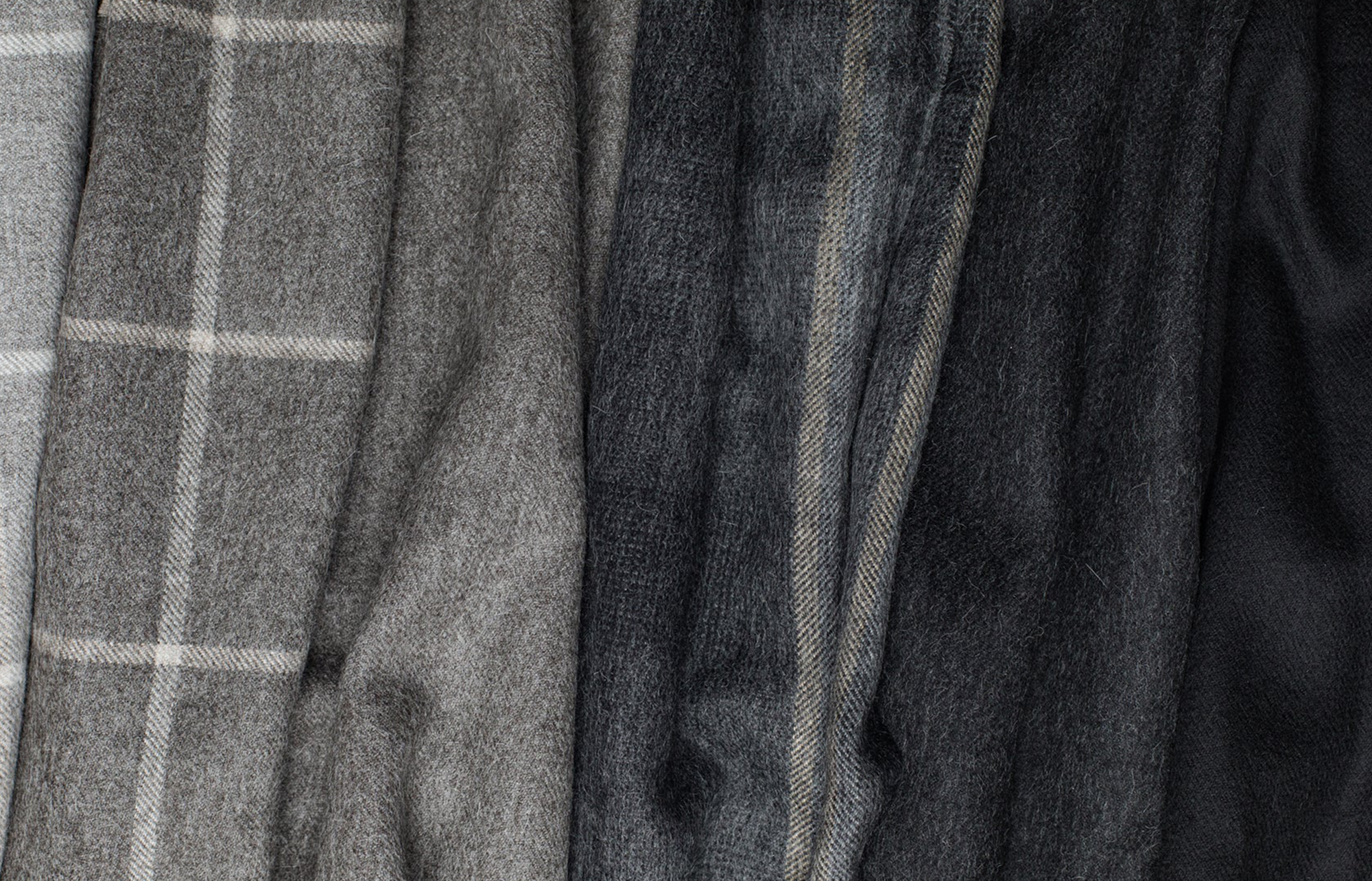
ALL ABOUT THE ALPACA
Alpaca fiber is hair that has been gathered from an alpaca. The alpaca is a llama-like animal, but alpacas are usually much smaller than their fellow camelid. There are two different breeds of alpacas, huacaya and suri, and each produces a slightly different type of fiber. Alpacas also come in 22 natural colors.
All alpaca wool fibers are extremely soft as a result of the small diameter of each fiber strand, and alpaca fiber is five times warmer and stronger than sheep’s wool due to the air pockets in the fiber, which allows it to trap and contain more heat. Alpaca fiber is considered extremely luxurious from it’s soft and durable nature, making it a fixture for winter wear clothing.
Alpaca fiber has a storied history dating back to the ancient tribes in the Andean
highlands, in Bolivia and Peru, where the alpaca’s ancestor, the vicuna, was first
domesticated. After selective breeding of the vicuna in the Andes, the alpaca was developed as an integral part to the Inca tribes’ survival. The animals were raised not just for their coats but also for meat.
Clothing made from alpaca fiber was reserved for royalty. Many of the alpacas died out when the Spanish conquistadors invaded the territory and deemed the Merino sheep more valuable, but in the 1800s, the English discovered the alpaca fiber and it regained popularity. Alpacas were exported around the world, and are raised in the United States, Australia, and New Zealand for their fiber. However, Peruvian alpaca fiber is still the most popular today.
Alpaca fiber comes from the alpaca, which are native to South America. Alpacas live in extreme climates, which helps them develop their coveted coats. Alpacas are generally shorn in the spring, which allows them to have shorter hair during the warmer months, and the raw fleece can be spun, dyed, woven, or felted. Although they are native to Peru, alpacas were exported to many countries around the world and live in the United States, Europe, and Australia as well.
Alpaca fiber has a soft, silky feel, and while it is warm like sheep wool, it does not have the same potentially itchy nature. This is because the alpaca’s fiber is naturally softer to the touch because it is several microns smaller in diameter, similar to merino wool, giving it its characteristic softness. Alpaca fiber is also naturally water resistant because it has an incredibly low water retention rate. Alpaca fiber is extremely warm, but it also maintains a lightweight nature, as the airiness of the fiber allows the wool to trap and retain heat without becoming too heavy.
There are two different breeds of alpacas, and each produces a distinct type of yarn:
1. Huacaya Alpaca: Huacaya alpacas are what most alpacas are, and the huacaya fiber is spongy with natural crimp. This texture gives the fiber an inherent elastic nature, which makes it a great fiber for knitwear.
2. Suri Alpaca: Suri alpacas have long, silky hair that look like dreadlocks. The Suri Alpaca fiber has no crimp, making it better suited for weaving. Suris are slightly more rare than Huacaya alpacas, as the breed was designated for royalty during Incan times.
Baby Alpaca
Unlike its name, baby alpaca is not shorn from actual baby alpacas. Instead, it
comes from the back of an adult alpaca, as the back area is generally not
contaminated by dirt. It has the same inherent characteristics of all alpaca, though is generally slightly softer.
From scarves to gloves to socks, alpaca garments are extremely popular, and alpaca products are made from a variety of different processes.
1. Knitwear: Alpaca is a favorite among fiber enthusiasts, and alpaca yarn is a
fixture of the hand-knitting community. Alpaca sweaters, alpaca cardigans,
alpaca socks, and more are created by knitters and crocheters. There are
several alpaca yarn weights—from a fingering or lightweight yarn to a medium
or worsted weight yarn to a chunky weight. Alpaca yarn can be pure alpaca or a
wool alpaca blend yarn, as alpaca adds softness and strength to any fibers it’s
spun with.
2. Spinning and dyeing: Hand-spinners also gravitate to alpaca, as alpaca is a
great spinning fiber. While many don’t dye alpaca as it comes in so many
beautiful natural colors, the lighter colors can be dyed as well. However, for
both spinning and dying, the guard hairs, i.e. the hairs from the legs, are
removed as they do not spin or hold dye well. Once the alpaca is spun and
dyed, it is assembled into a skein, the term of a length of yarn organized in a coil.
3. Felting: Alpaca is also a great fiber for felting, which involves matting and
condensing the fibers together to form felt. Hot water and soap is used to
agitate the fibers; the process can also be done using a washing machine.
4. Weaving: Alpaca yarn is a popular material for weaving, and a woven alpaca
garment, like a scarf, is usually very dense and warm.
Advantages Of Using Alpaca Fiber
1. Sturdy: Since alpaca doesn’t have lanolin or any excess secretions, the
fineness of the wool yarn makes it less likely to pill.
2. Lightweight: Alpaca fiber boasts air pockets within its hairs, which gives the
fiber a lightweight quality without sacrificing warmth. These air pockets also
make the material extremely breathable.
3. Luxurious: Alpaca is similar to cashmere in its soft, luxurious feel and incredible
warmth and lightweight qualities. While alpaca fiber is still considered a luxury
item, alpaca is slightly more accessible and affordable than cashmere.
Fabric Care Guide: How to Care For Your Alpaca Garments
Alpaca wool is not machine washable, as the process can damage the wool. Alpaca garments should always be hand washed.
- Soak your alpaca garment with a mild wool soap in a basin.
- After the item has soaked, gently agitate and rinse, making sure you support the weight of the item so that it does not stretch.
- Squeeze out the excess water, but do not wring so it doesn’t lose its shape, always supporting the item’s weight.
- Lay flat to dry, and make sure to reshape the garment accordingly.



Leave a comment
This site is protected by hCaptcha and the hCaptcha Privacy Policy and Terms of Service apply.